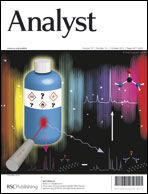Visual determination of Cu2+ through copper-catalysed in situ formation of Ag nanoparticles†
Abstract
A new strategy was explored for the visual determination of Cu2+ using copper-catalysed in situ formation of Ag nanoparticles. In this method, only common reagents were used and the pre-synthesis and modification of nanoparticles are avoided. Ag+ can form a milk-white suspension (AgBr) with Br− in an aqueous solution composed of AgNO3, cetyltrimethylammonium bromide, ascorbic acid, bovine serum albumin, and NaNO3. The reaction will be stopped by addition of Cu2+, accompanied by a colour change from milk-white to orange or brilliant yellow. Cu+ (the reduction product of Cu2+) consumes the dissolved O2 and prevents the O2 from oxidizing the newly reduced Ag atoms (by ascorbic acid) back to Ag+, facilitating the further aggregation of Ag atoms to become Ag nanoparticles. The visible colour change was shown to be specific towards Cu2+ over most other metal ions. The limit of detection was 0.75 μM Cu2+ by the naked eye and 0.25 μM by spectrometer. Quantitation of Cu2+ was achieved in a linear range from 0.25 to 2.0 μM. This method was validated by measuring real water and serum samples, giving results agreeing well with the data reported and measured by inductively coupled plasma mass spectrometry. The recovery was 95.6–106% for untreated tap water and 96.0–100% for resin-pre-treated water and serum samples.


 Please wait while we load your content...
Please wait while we load your content...